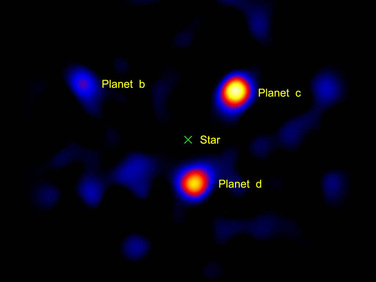Move around
To see all the stars with exoplanets, use the hand tool to move around the sky.Each of the stars you see highlighted by a green circle has at least one planet. These are other worlds orbiting distant stars!
Astronomers have only recently been able to detect these planets. The problem is that a planet is much fainter than its parent star—less than a billionth as bright. Even the largest and brightest of these exoplanets gets lost in the glare of its star.
Luckily, there are indirect ways of detecting exoplanets by measuring the effects a planet has on its star. One is to detect the gravitational tug of a planet as it orbits its parent star, which makes the star sway back and forth. Another method is to detect the dimming that occurs when a planet passes between a star and an observer back on Earth.
Since planets don't emit their own light, it's hard to detect them optically. Missions, such as Kepler, use advanced technologies to detect Earth-sized planets directly. Perhaps one day we will be able to see the surface of a world orbiting a distant star!
Let us take a closer look at some of the methods that have proved successful for detecting planets around other stars.
Radial Velocity
As a planet orbits a star, the star also moves in its own small orbit around the system's center of mass. Variations in the star's radial velocity—that is, the speed with which it moves towards or away from Earth—can be detected from displacements in the star's spectral lines due to the Doppler effect. Extremely small radial-velocity variations, of 1 m/s or even somewhat less, can be observed. This has been by far the most productive method of discovering exoplanets. It has the advantage of being applicable to stars with a wide range of characteristics. One of its disadvantages is that it cannot determine a planet's true mass, but can only set a lower limit on that mass. However, if the radial velocity of the planet itself can be distinguished from the radial velocity of the star, then the true mass can be determined.
Transit Method
If a planet crosses (or transits) in front of its parent star's disk, then the observed brightness of the star drops by a small amount. The amount by which the star dims depends on its size and on the size of the planet, among other factors. This has been the second most productive method of detection, though it suffers from a substantial rate of false positives and confirmation from another method is usually considered necessary. The transit method reveals the radius of a planet, and it has the benefit that it sometimes allows a planet's atmosphere to be investigated through spectroscopy. Because the transit method requires that part of the planet's orbit intersect a line-of-sight between the host star and Earth, the probability that an exoplanet in a randomly oriented orbit will be observed to transit the star is somewhat small.
Orbital Brightness Modulations
Orbital brightness modulations observe the apparent brightness of a host star changing caused by the planet orbiting around it.
Timing
When multiple planets are present, each one slightly perturbs the others' orbits. Small variations in the times of transit for one planet can thus indicate the presence of another planet, which itself may or may not transit. For example, variations in the transits of the planet Kepler-19b suggest the existence of a second planet in the system, the non-transiting Kepler-19c. If multiple transiting planets exist in one system, then this method can be used to confirm their existence. In another form of the method, timing the eclipses in an eclipsing binary star can reveal an outer planet that orbits both stars; as of August 2013, a few planets have been found in that way with numerous planets confirmed with this method.
Gravitational Microlensing
Microlensing occurs when the gravitational field of a star acts like a lens, magnifying the light of a distant background star. Planets orbiting the lensing star can cause detectable anomalies in the magnification as it varies over time. Unlike most other methods, which have detection bias toward planets with small (or for resolved imaging, large) orbits, the microlensing method is most sensitive to detecting planets around 1–10 AU away from sun-like stars.
Direct Imaging
All exoplanets that have been imaged directly by telescopes are both large (more massive than Jupiter) and widely separated from their parent stars. Most of them are also very hot, so that they emit intense infrared radiation; the images have then been made at infrared where the planet is brighter than it is at visible wavelengths.
Specially designed direct-imaging instruments such as Gemini Planet Imager and VLT-SPHERE will image dozens of gas giants, however the vast majority of known exoplanets have only been detected through indirect methods such as radial velocity measurements.
